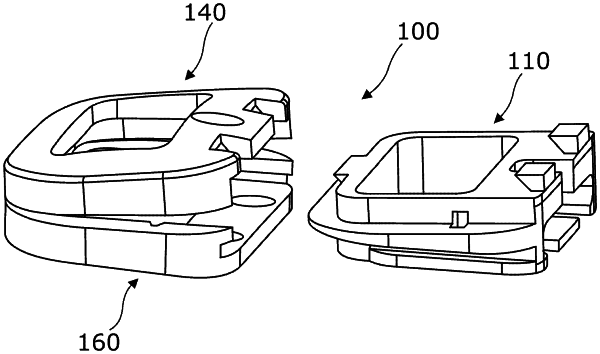| CPC A61F 2/4455 (2013.01) [A61F 2002/30112 (2013.01); A61F 2002/30266 (2013.01); A61F 2002/30331 (2013.01); A61F 2002/3054 (2013.01); A61F 2002/30556 (2013.01); A61F 2002/30736 (2013.01)] | 20 Claims |

|
1. An intervertebral fusion device comprising:
a superior component having a superior component top side and a superior component bottom side, the superior component configured to be received in an intervertebral space between first and second vertebrae whereby the superior component top side abuts against the first vertebra;
an inferior component having an inferior component top side and an inferior component bottom side, the inferior component configured to be received in the intervertebral space between the first and second vertebrae whereby the inferior component bottom side abuts against the second vertebra, the superior component bottom side and the inferior component top side opposing each other when the superior and inferior components are received in the intervertebral space; and
a core component configured for insertion between the superior and inferior components whereby a separation between the superior and inferior components is determined,
wherein the core component comprises a retention mechanism which moves in the medial-lateral direction between contracted and expanded conditions whereby the core component is of greater extent in the medial-lateral direction when in the expanded condition than when in the contracted condition by virtue of movement of the retention mechanism, the core component insertable between the superior and inferior components when the retention mechanism is in the contracted condition, and the retention mechanism cooperates with a surface profile defined on each of the superior and the inferior components when in the expanded condition whereby the core component interlocks with the superior and inferior components to present resistance to movement of the core component from between the superior and inferior components in a direction opposite to the direction of insertion,
wherein the core component is of smaller extent in the medial-lateral direction when in the contracted condition than when in the expanded condition whereby the retention mechanism is movable past the surface profiles to allow for insertion of the core component between the superior and inferior components,
wherein the core component is integrally formed and the retention mechanism is integral to the core component whereby the core component is structured to be operative as the retention mechanism,
wherein the core component is configured such that it is resiliently compressible in the medial-lateral direction whereby the core component moves under compression from the expanded condition to the contracted condition,
wherein the core component has a posterior side and an anterior side, the posterior and anterior sides oppositely directed and the posterior side received between the superior and inferior components before the anterior side when the core component is inserted between the superior and inferior components, and
wherein the core component has first and second lateral sides which face in opposite directions with each of the first and second lateral sides facing in the medial-lateral direction, the core component structured such that the first and second lateral sides at the anterior side are not compressed towards each other when a compressive force is applied and such that the first and second lateral sides at the posterior side are compressed towards each other when the compressive force is applied.
|